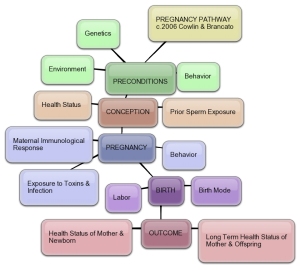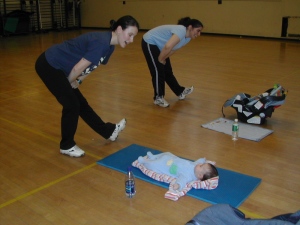Pregnancy Pathway…Important Notes from Wonderrobyn
The following are notes from co-author Robyn Brancato, CNM (certified nurse midwife) who practices in New York City, or, as she is know here: Wonderrobyn! You can read about both authors in the About tab above. Here they are on the beach in San Diego, when they gave a talk at conference there a couple years ago. Robyn on the left, Ann on the right.

Robyn and Ann, Pathway authors
1. Addition to Small Rant: “Resist the temptation to watch A Baby Story on TLC! It does not portray birth accurately, as they condense 15 hours of labor into 30 minutes and play up the drama so that you will be on the edge of your seat! In the majority of women, birth is not that dangerous.”
2. Regarding: When does conception occur? “This is a really interesting post… I love the discussion about at what point conception occurs! Personally, I like the Biblical notion of quickening. Even though this varies from woman to woman and can range anywhere from 16 to 22 weeks gestation, it seems like the most natural theory.”
Dear Reader: What do YOU think? Did you read the conception post on March 23, ’09?
3. About sperm & preeclampsia. “Is the connection between barrier methods and preeclampsia actually established? I have read studies stating the contrary — that barrier methods have no effect on preeclampsia rates.”
HURRAY! THIS REQUIRES FURTHER CONSIDERATION.
More information: The immune maladaptation theory suggests that tolerance to paternal antigens, resulting from prolonged exposure to sperm, protects against the development of preeclampsia. Thus, barrier methods and being young may predispose women to this major disorder of pregnancy.
Evidence exists on both sides of this theory. Here are two recent studies (one of each) that readers may find helpful in understanding this idea. Keep in mind that other factors than just sperm exposure may be affecting research findings. But, it does seem that under some conditions, barrier methods and amount of exposure to sperm can affect the pregnancy itself.
Ness RB, Markovic N, Harger G, Day R. Barrier methods, length of preconception intercourse and preeclampsia, Journal: Hypertension in Pregnancy 23(3):227–235. 2005. Results did not support the immune maladaption theory.
Yousefi Z, Jafarnezhad F, Nasrollai S, Esmaeeli H. Assessment of correlation between unprotected coitus and preeclampsia, Journal of Research in Medical Sciences 11(6):370–374. 2006. In a matched controls study, women with <4 months cohabitation or who used barrier methods had higher risks of developing preeclampsia than those with >4 months cohabitation. Oral contraception users had a lower preeclampsia rate than those who used no oral contraception.
In a commentary article in OB/GYN News , July 1, 2002, the following note was made by Dr. Jon Einarsson: With insufficient exposure, pregnancy may induce an immune response and preeclampsia in some women with predisposing factors such as an endothelium that already is sensitive to injury due to age, insulin resistance, or preexisting hypertension.
Is there a plain and simple truth about sperm exposure and pregnancy risks? Alas, no. But, know your circumstances. If you are young, protect yourself. Wear a condom. When you are ready to be a mom, you will be ready to figure out your risks. So, this, too follows the axiom:
Events in life are rarely plain and never simple.








